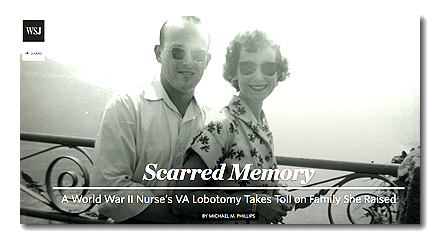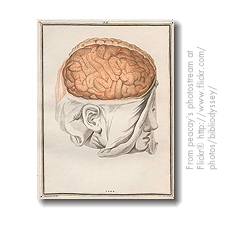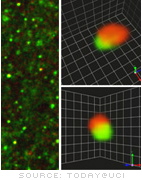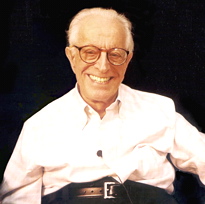How Have We Depicted Madness Through History

Scarred Memory: A World War II Nurse's Lobotomy

by Michael M. Phillips
"Dorothy is one of the last survivors among roughly 2,000 psychiatrically ill veterans the Veterans Administration lobotomized in the 1940s and 1950s. The Wall Street Journal in 2013 first detailed the VA lobotomy program and profiled the troubled life of World War II pilot Roman Tritz, 91, the only living lobotomized veteran the newspaper could locate at the time.
Lawmakers then asked the VA to find other surviving lobotomized veterans. VA headquarters, which says its files on such old cases are archived and difficult to access, hadn’t found any other survivors when Dorothy’s family contacted the Journal."
Lives in the Asylum

A collection of four stories gathered on the Longreads blog site.
1. "Something More Wrong" (Katherine B. Olson, The Big Roundtable, July 2013)
2. "Mentally Unfit" (Zachary McDermott, Gawker, April 2014)
3. "My Lovely Wife in the Psych Ward." (Mark Luckach, Pacific Standard, January 2015)
4. "Mr Bad Weekend" (Alan Hanson, Matter, January 2015)
Félix Vicq D'Azyr (1786) Brain Images

BTW, while he died during The Terror period of the French Revolution (1794), his passing was due to pneumonia rather than the guillotine.
I was struck both by how beautiful the engravings are as well as their accuracy/informative quality. A link is provided to the set on Flickr® with varying sizes available of each plate for download and use.
At the bottom of the entry, there is a very helpful list of online sources regarding Vicq D'Azyr and this volume.
The Split Brain
What Happened to the Girls in Le Roy?
| "Before the media vans took over Main Street, before the environmental testers came to dig at the soil, before the doctor came to take blood, before strangers started knocking on doors and asking question after question, Katie Krautwurst, a high-school cheerleader from Le Roy, N.Y., woke up from a nap. Instantly, she knew something was wrong. Her chin was jutting forward uncontrollably and her face was contracting into spasms. She was still twitching a few weeks later when her best friend, Thera Sanchez, captain of one of the school's cheerleading squads, awoke from a nap stuttering and then later started twitching, her arms flailing and head jerking. Two weeks after that, Lydia Parker, also a senior, erupted in tics and arm swings and hums. Then word got around that Chelsey Dumars, another cheerleader, who recently moved to town, was making the same strange noises, the same strange movements, leaving school early on the days she could make it to class at all. The numbers grew--12, then 16, then 18, in a school of 600--and as they swelled, the ranks of the sufferers came to include a wider swath of the Le Roy high-school hierarchy: girls who weren't cheerleaders, girls who kept to themselves and had studs in their lips. There was even one boy and an older woman, age 36…" |
Wellcome Collection: Brains

"Our major new free exhibition seeks to explore what humans have done to brains in the name of medical intervention, scientific enquiry, cultural meaning and technological change. Featuring over 150 artefacts including real brains, artworks, manuscripts, artefacts, videos and photography, 'Brains' follows the long quest to manipulate and decipher the most unique and mysterious of human organs, whose secrets continue to confound and inspire. 'Brains' asks not what brains do to us, but what we have done to brains, focusing on the bodily presence of the organ rather than investigating the neuroscience of the mind."
A series of images galleries displays figures which illustrate
- Measuring-Classifying
- Modelling-Mapping
- Cutting-Treating
- Giving-Taking
Hudson River State Hospital
![[Hudson River State Hospital Old Building Drawin]](page0_blog_entry10_1.jpg)
Driving onto the property of the Hudson River State Hospital took visitors into a very different world than the one outside the hospital's stone walls. In the mid-1960s, the patient population living on the grounds of the facility could be numbered in the thousands (at its height, the hospital lodged about 9,000 patients in a mostly self-sustained and enclosed "total institution" as Erving Goffman would have termed it). As our car wound its way past the older buildings on the campus (the picture to the upper left is a drawing of the original "Kirkbride" building at HRSH), we would see many groups of patients being led from one place to another by staff members while, in other spots, patients were sitting in chairs or on benches simply staring out at whatever could be found nearby. It was, I recall, a very quiet environment and few of the mostly older and dilapidated-looking residents seem to speak at all to anyone nearby. Nonetheless, the grounds went on and on and occupied many tree-filled acres.
Psychologist Michael Britt, Ph.D. offers a glimpse into the Hudson River State Hospital (HRSH, later renamed the Mid-Hudson Psychiatric Center), in a recently-posted podcast interview on his website, The Psych Files. Dr. Roger Christenfeld, Research Director at a drastically-smaller current facility, discusses the history and therapeutic work of the HRSH in his interview with Britt. During 33 minutes, Christenfeld provides a glimpse of why the hospital was built and opened in 1869, what life was like for many patients in the late 19th and early 20th centuries, and how the notion of a state psychiatric facility changed profoundly after about 1955.
Target Link: Episode 27: From Insane Asylum to Psychiatric Center: A Brief History (33 minutes, the interview is in mp3 format and can be downloaded to your computer)
Associated Resources
- Historic 51: A website devoted to the history of the Hudson River State Hospital. Includes many images and other information (e.g., a timeline) telling the story of the HRSH
- Kirkbride Buildings: This website has photos of the "Kirkbride" style building at HRSH, a standard form for psychiatric asylum buildings in the 19th century. As the introduction to this site explains: "Once state-of-the-art mental healthcare facilities, Kirkbride buildings have long been relics of an obsolete therapeutic method known as Moral Treatment. These massive structures were conceived as ideal sanctuaries for the mentally ill in the latter half of the nineteenth century. Careful attention was given to every detail of their design in order to promote a healthy environment and to convey a sense of respectable decorum. Placed in secluded areas within expansive grounds, many seemed almost palace-like from the outside. But growing populations and insufficient funding led to unfortunate conditions that spoiled their idealistic promise."
Searching for the "Engram" and Finding It at UC-Irvine
Following upon the work of Ramon y Cajal and Sherrington, the Canadian neuropsychologist, Donald O. Hebb (1904-1985), disagreed with Lashley and argued for a mechanism by which memories could be localized, i.e., his proposal for the "Hebbian synapse" on the neuron and collections of such synapses across associated neurons in the form of "cell assemblies" (see Brown & Milner, 2003, for a longer appreciation of Hebb's contributions). For the past four decades, the focus for identifying Hebbian synapses has been undertaken under the overarching research concern for long-term potentiation (LPT), that is, the assumption that "information is storied in the brain as changes in synaptic efficiency..." and that "the location of storage, the engram of learning and memory, must therefore be found among those synapses which support activity-dependent changes in synaptic efficiency" (Bliss & Collingridge, 1993, p. 31).

So, more than a century after Semon proposed a role for a physical trace in the brain's cell in the establishment of a memory, laboratory research has appeared to confirm this finding.the study shows that synaptic connections in a region of rats' brains critical to learning change shape when the rodents learn to navigate a new, complex environment. In turn, when drugs are administered that block these changes, the rats don’t learn, confirming the essential role the shape change plays in the production of stable memory...Working with advanced microscopic techniques called restorative deconvolution microscopy, the UC Irvine team found that the LTP-related markers appear during learning and are associated with expanded synapses in the hippocampus. Because the size of a synapse relates to its effectiveness in transmitting messages between neurons, the new results indicate that learning improves communication between particular groups of brain cells. (UC Irvine scientists, 2007, July 25).
Target article: Fedulov, V., Rex, C. S., Simmons, D. A., Palmer, L., Gall, C. M., & Lynch, G. (2007). Evidence that long-term potentiation occurs within individual hippocampal synapses during learning. Journal of Neuroscience, 27(30), 8031-8039. [Link to abstract]
Press release: UC Irvine scientists unveil the 'face' of a new memory [Press release]. (2007, July 24). Today@UCI. Retrieved July 31, 2007 from the UCI website: http://today.uci.edu/news/release_detail.asp?key=1638
References
Bliss, T. V. P., & Collingridge, G. L. (1993, Jan 7). A synaptic model of memory: Long-term potentiation in the hippocampus. Nature, 361(6407), 31-39.
Brown, R. E., & Milner, P. M. (2003). The legacy of Donald O. Hebb: More than the Hebb synapse. Nature Reviews Neuroscience, 4, 1013-1019. Retrieved July 31, 2007 from http://www.nature.com/nrn/journal/v4/n12/full/nrn1257_fs.html
Cherkin, A. (1966, Jan 15). Toward a quantitative view of the engram. Proceedings of the National Academy of Sciences of the United States of America, 55(1), 89-91.
Hebb, D. O. (1949). The organization of behavior: A neuropsychological theory. New York: Wiley. (Reprinted by Lawrence Erlbaum Associates, 2002.)
Semon, R. (1904). Die Mneme als erhaltendes Prinzip im Wechsel des organischen Geschehens. Leipzig, Germany: Wilhelm Engelmann.
Semon, R. (1921). The mneme. London: Allen and Unwin.
Wellcome Trust Opens Image Collection Online
Albert Ellis Dies at 93

Target article: Kaufman, M. T. (2007, July 25). Albert Ellis, influential psychotherapist, dies at 93. New York Times. Retrieved July 24, 2007 from the New York Times website.
Resources: Albert Ellis Institute | Albert Ellis (@ Wikipedia)
